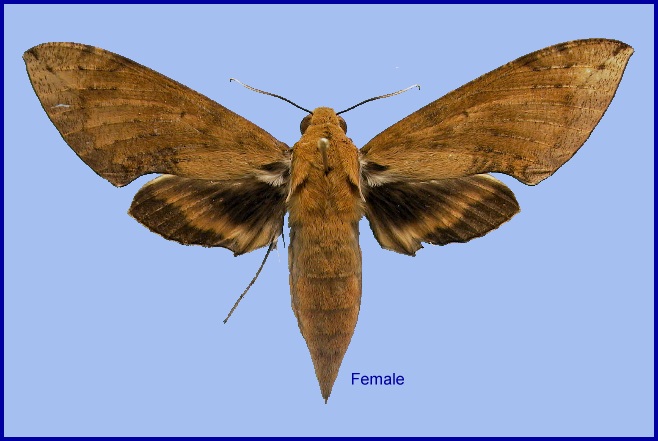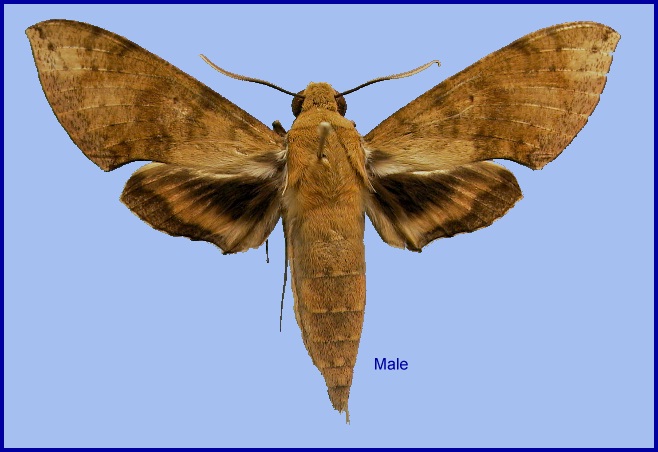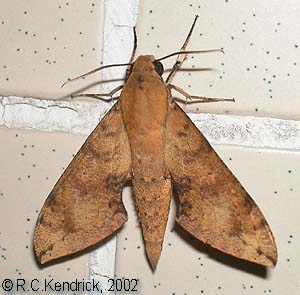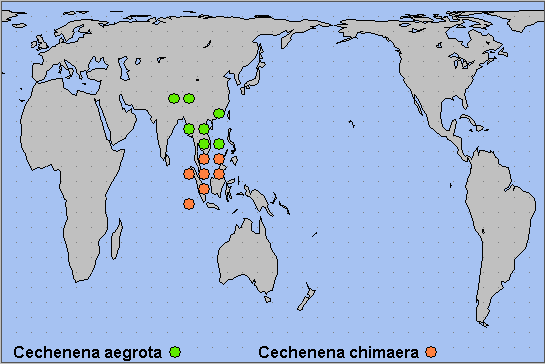

Pergesa aegrota Butler, 1875, Proc. zool. Soc. Lond. 1875: 246. Type locality: [Bangladesh,] Silhet [Sylhet].
Synonym. Pergesa aegrota Butler, 1875.
Synonym. Cechenena albicosta Tutt, 1904.
Synonym. Cechenena aegrota occidentalis Clark, 1935.
Wingspan: 80--100mm. This species is sexually dichromatic, with females being darker and browner than the males. In the male, forewing upperside ground colour yellowish-buff; subbasal and antemedian lines clearly marked; apex with a black spot that continues as a serrate line across veins Rs4 and M1, then expands into a comma-shaped mark between veins M1 and M2. Forewing underside beige with a blackish basal area. Hindwing upperside dark brown; median band dirty yellow, extending from costa to tornus without any reduction in width along its length; costa pure yellow along entire length. Underside of body beige with a slight greenish tone. Underside of abdomen with a series of paired small black spots on segments 2-7. Female similar to the male but wings more rounded, forewing upperside pattern generally less marked and abdomen fatter.
In the male genitalia, uncus similar to Rhagastis velata. Gnathos similar to Rhagastis velata. Harpe thick and very short, apically produced as a sharply pointed upcurved hook. Phallus apically rounded and lacking a transverse process; instead it bears a distal field of sharp deciduous spicules and apically there are 5-7 shorter points.

China: 7.iii (Hainan); iii-xii (Hong Kong); iv (Yunnan; Hainan); 28.v (Hainan); 8.vi (Guangdong); 13.vi (Guangxi); vi-vii (Yunnan); 2.vii (Yunnan); 7-15.viii (Yunnan).
Kendrick (2002) states that this common species is multivoltine in Hong Kong, occurring from March until December, with a main peak in April.
OVUM:
Unrecorded.
LARVA:

PUPA:

Larval hostplants. Psychotria.
Unknown.
China: Yunnan (Simao/Pu'er; Lincan Co., Daxueshan; Zhaotong; Mengla; Mangao; Menglunzhen; Xishuangbanna Tropical Botanic Garden); Guangdong (Shangshuituan; Danzhuba); Hong Kong (Kowloon); Guangxi (Longtan National Forest Park, nr Guiping; Nanning); Hainan (Jianfeng; Lingshui Li Autonomous County; Diaoluo Shan National Forest Park; Tianfu Shengong; Zhiqing Forest).
Nepal, northeast India (Sikkim, Meghalaya), Bhutan (Irungbam & Irungbam, 2019), Bangladesh, Thailand, Laos, southern China (Hainan, Hong Kong) and Vietnam (Le & Vu, 2024). [Adults resembling Cechenena aegrota from Malaysia (Peninsular, Sarawak), Indonesia (Sumatra, Java, Kalimantan) and Palawan Island are now known to be the distinct species Cechenena chimaera (Rothschild, 1894).]

 Return to Sphingidae of the Eastern Palaearctic species list
Return to Sphingidae of the Eastern Palaearctic species list